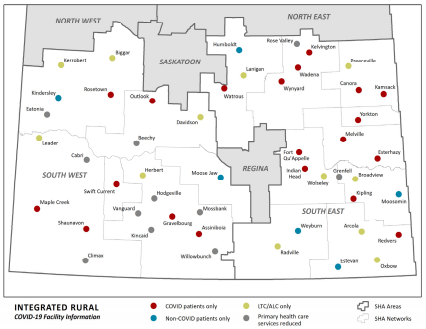Hospitals in Saskatchewan’s rural and remote communities are set to have different COVID-19 designations as the novel coronavirus continues to spread.

The Saskatchewan Health Authority (SHA) plans to have a mix of non-COVID and COVID-designated hospitals in rural areas.
The province’s response to the pandemic will be staged based on demand, said Dr. Kevin Wasko, SHA’s executive physician for integrated rural health.
“These are not going to become COVID hospitals overnight,” Wasko said in a web conference with reporters on Thursday.
“They would become COVID hospitals when the incidence and prevalence of COVID-19 in that particular geography would indicate that patients require that care as close to home as possible.”
If demand becomes high enough, COVID-designated hospitals would only admit infected patients, though their emergency departments would remain open to everyone, the SHA said.

The phased approach would see the sickest COVID patients make use of intensive care facilities in Swift Current and Yorkton, said integrated rural health vice-president Karen Earnshaw.
Those are the only rural centres that will have ventilators for COVID-19 patients, while Moosejaw will have ventilators for people with other ailments.
Wasko said it’s possible some rural patients would receive treatment in Saskatoon or Regina.
Hospitals in some larger rural centres including Estevan, Moosejaw and Weyburn have been designated non-COVID facilities because they offer speciality services, he said.

Get weekly health news
“Because they are district or regional hospitals, they do have a higher level of care and they do have a bigger draw where they could care for the non-COVID needs of our patients,” he said.
The plan is for non-COVID hospitals to operate business-as-usual. People who test positive will not be admitted.
“The physician would call for advice from a central physician on call and a coordinator that would then determine the best place for that patient to be admitted,” Wasko said.
Transport of patients between locations will be managed in partnership with EMS and the hospital, Earnshaw said.
There aren’t any COVID-19-designated hospitals north of Saskatoon.
Instead, the SHA plans to have non-COVID-19 hospitals and mixed-patient hospitals, which would have wards dedicated to people infected by the novel coronavirus.

Andrew McLetchie, SHA’s vice-president of integrated northern health, said COVID-only hospitals weren’t deemed necessary for the north.
“The general rationale for it was that a lot of our facilities are quite large — like Prince Albert, Battleford, and Lloydminster — that they serve very… diverse populations,” he said
“We felt within those facilities, we were able to separate… patients and staff effectively to not create cross-contamination.”
Saskatchewan’s Federation of Sovereign Indigenous Nations has expressed concerns that northern communities are ill-equipped for the pandemic.
McLetchie said the SHA is working hard to ensure people who live in remote and fly-in communities have access to care.
“We’ve been working with our EMS providers… on the strategy for it,” he said.
“We… have a mixture of land-based EMS and flight-based EMS that would respond to those communities with the paramedics trained… in the use of PPE prepared to transport patients as needed.”
He said there are plans to establish on-site testing in northern communities, hopefully within the next two weeks.
Questions about COVID-19? Here are some things you need to know:
Health officials caution against all international travel. Returning travellers are legally obligated to self-isolate for 14 days, beginning March 26, in case they develop symptoms and to prevent spreading the virus to others. Some provinces and territories have also implemented additional recommendations or enforcement measures to ensure those returning to the area self-isolate.
Symptoms can include fever, cough and difficulty breathing — very similar to a cold or flu. Some people can develop a more severe illness. People most at risk of this include older adults and people with severe chronic medical conditions like heart, lung or kidney disease. If you develop symptoms, contact public health authorities.
To prevent the virus from spreading, experts recommend frequent handwashing and coughing into your sleeve. They also recommend minimizing contact with others staying home as much as possible and maintaining a distance of two metres from other people if you go out.
For full COVID-19 coverage from Global News, click here.












Comments